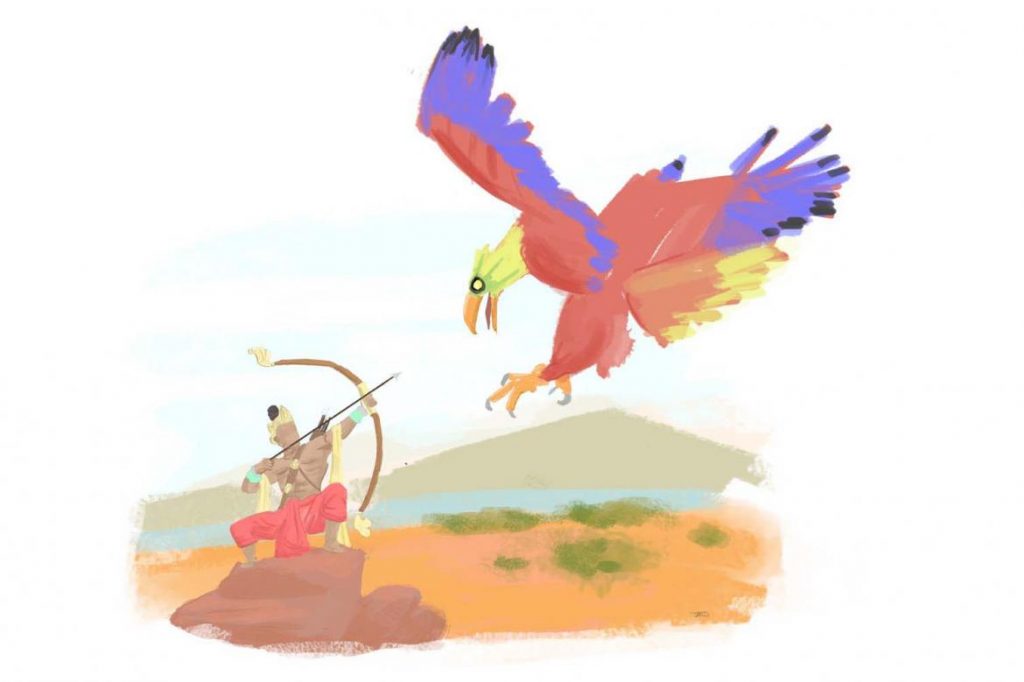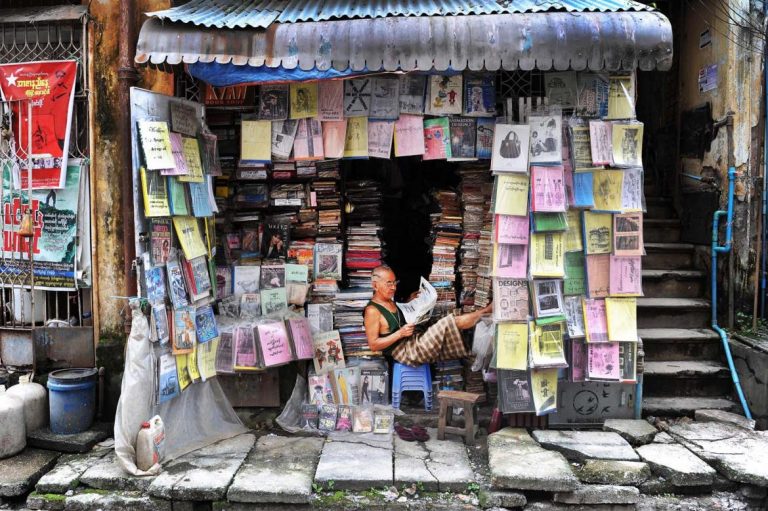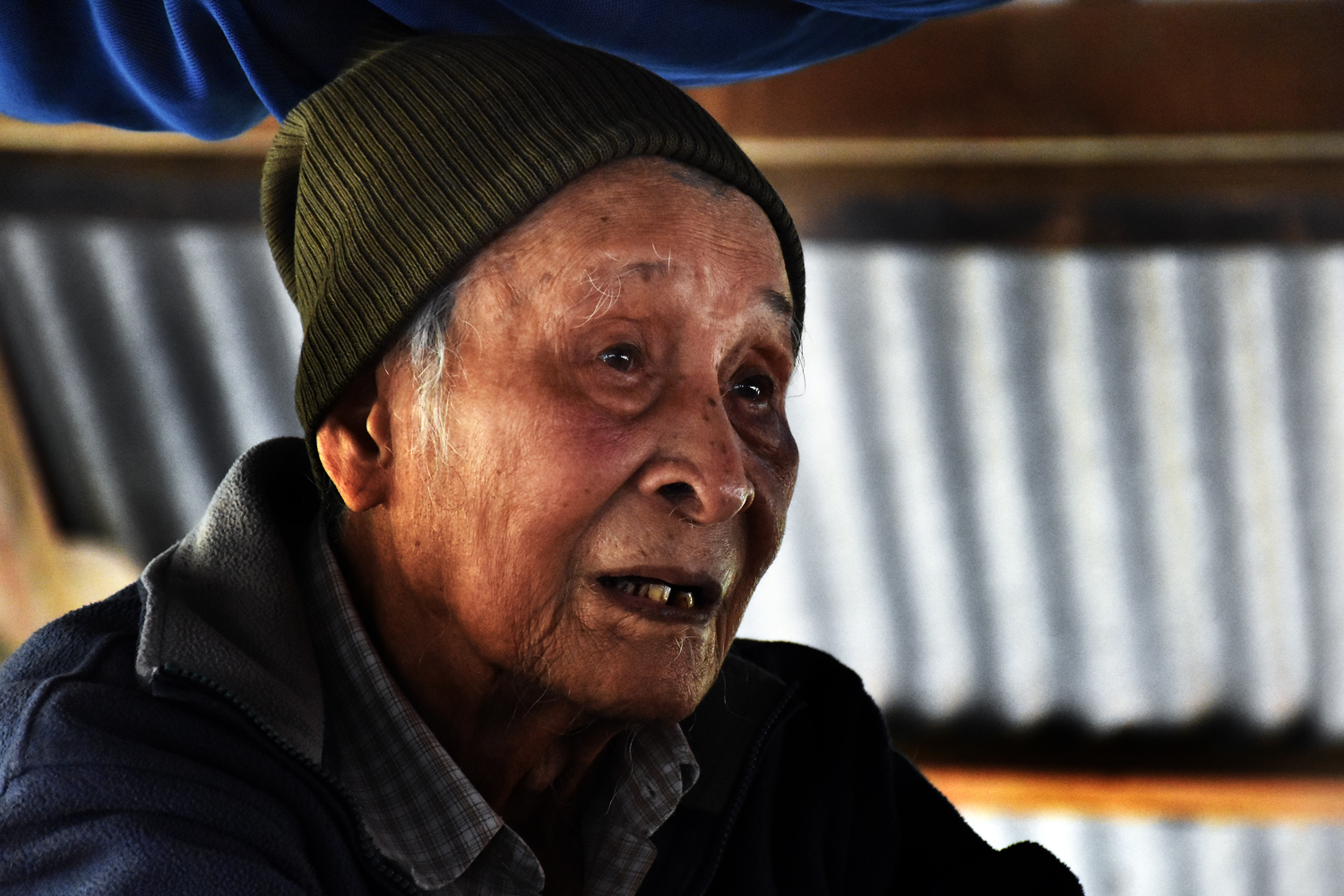A brief survey of the tales of might and magic in Myanmar’s most important historical text.
By JARED DOWNING | FRONTIER
IT IS 1829. The Konbaung Dynasty has suffered a humiliating defeat to the British, and as foreign domination looms, King Bagyidaw turns to history to galvanise his ancient kingdom.
The Hmannan Maha Yazawindawgyi, or, as its English translation is titled, The Glass Palace Chronicle of the Kings of Burma, is the last comprehensive history before the British conquest.
The Glass Palace Chronicle of the Kings of Burma was so-named because of the glass-lined royal chamber in which the Konbaung scholars combed through the earliest available historical texts to present what they say is an unbroken royal line that stretches back four centuries before the birth of the Buddha.
Although the English translation, published by Pe Maung Tin and G H Luce in 1923, only covers the period before the Mongol invasions in the 13th century, those sections are packed with history, religion and mythology; ogres, witches and demons; historically accurate rulers and legendary heroes.
The first kings of Myanmar: Abiyaza and the scions of Tagaung
Support more independent journalism like this. Sign up to be a Frontier member.
The English-language Glass Palace Chronicle begins at the second part of the Myanmar-language Hmannan Maha Yazawindawgyi (the first part, it claims, is merely a retelling of the history of Buddhism).
It opens with the story of the (probably mythical) King Abiyaza (a sort of Myanmar King Arthur) an Indian prince of the Sakiyan clan, the same clan of the Buddha Gautama himself. After the Sakiyan lost a devastating war over a snubbed marriage proposal, Abiyaza passed into the Ayeyarwady Valley to found a new kingdom at Tagaung.
In this story, Myanmar’s tradition of temple-building begins here. At Abiyaza’s death, his sons Kanyaza Gyi and Kanyaza Nge vied for the throne with a “war of merit” – that is, who could build the best alms hall in a single night. Where the Kanyaza Gyi tried and failed to build a colossal structure of brick, the younger Kanyaza Nge successfully completed a modest altar of bamboo and wood.
Defeated, Kanyaza Gyi gathered his armies and founded a new kingdom to the south. As the story goes, these two brothers’ descendants would populate the land with its first city states and empires.
The Sakiyans would fall, once again, in a marital dispute, when a Sakiyan ruler gave a neighbouring king the hand of a slave woman instead of his own daughter. Their son, upon learning of his ignominious heritage, would raise an army and shatter the clan, sending them fleeing across the Ayeyarwaddy Valley.
Among these decedents are King Dwattabaung (443-373 BCE), who had a magic spear that, when thrown from a particular hill, would hover over his rival kings’ heads until they submitted. His kingdom was vast and rich, but when he seized a single plot of monastery land, donated by a peasant woman, his spear lost its magic and Dwattabaung was ruined.
Later, the teenage cook in the house of a nobleman accidentally became King Ngataba (111-60 BCE) after eating the head of a talking rooster that had prophesised kinghood for anyone who devoured it. (But he was “not of royal bone” and thus had no heir.)
But perhaps the Chronicle’s greatest early legend is that of Pyusawhti, a 2nd century prince of Sakiyan lineage whose acts of derring-do would spawn the kingdom of Bagan.
Prince Pyusawhti and the great beasts
The Chronicle presents two parentages for Pyusawhti: First, as the son of a Sakiyan scion living in exile, and second, as an abandoned hatchling of a dragon maiden knocked up by a prince of the Sun Men.
When he became a man Pyusawhti inherited (from either his human or solar father) a magic bow, and the young prince left his home in search of adventure. When he came to the land of Bagan, he found it dominated by a great tiger, a great boar, a great flying squirrel and a great bird. The last of which demanded a fresh maiden to eat each day.
Pyusawhti slew each in turn with his magic bow, was awarded the hand of the chieftain’s daughter and built Bagan into a proper kingdom.
The scholarship of the Glass Palace Chronicle
Again, the chroniclers present two versions of Pyusawhti’s birth and then put them to exhaustive scrutiny, consulting various texts on local geography, the nature of the Sun Men and the colours of dragon eggs.
It illustrates that the mythology and religion in Glass Palace is meant to be taken as seriously as the dates and lineages.
For example, when a Tagaung heir pursues and slays a giant boar that had ravaged the land around 500 BCE, the chroniclers include such comments:
In the Great Chronicle it appears that the boar ran thence south-west and crossed the Ayeyarwady, that so vast was he in stature that in entering the river he wetted not even the skin of his belly…. Not whereas the old thamaing and the chronicles declare that the height of the boar slain by the Tagaung heir was but twelve cubits, this conflicts with the statement that in crossing the river Ayeyarwady he wetted not even the skin of his belly.
King Anawrahta builds an empire
Perhaps the most important history is that of King Anawrahta (1014-1078 CE). Anawratha holds similar place in the Chronicle (and indeed Myanmar history in general) as King David does in the Bible – a ruler as strong as he was pious who founded an empire and oversaw a lasting age of peace and prosperity.
As a young prince of Bagan, Anawrahta saw his father’s throne usurped by his older half-brother Sokkate, who took Anawratha’s own mother as queen. The two raised armies and – after some dramatic, Game of Thrones-style build up – Anawrahta challenged Sokkate to a duel.
“His mother’s milk is yet wet upon his lips, and he sayeth he will fight me!” Sokkate bragged. “Let all my ministers look on. I will fight him, man to man, on horseback!”
Anawratha allowed Sokkate the first throw of the spear, and when his shot missed, ran his older brother through.
More exciting tales (and dull academic discourse) pepper Anawrahta’s three-decade reign in which he forges Myanmar’s first great empire.
But perhaps more emphasised than his military might are his acts of religious merit. When the king (after a long and exciting struggle) acquired a tooth of the Buddha, he placed it on the back of a white elephant and then built a pagoda (the Shwezigon, at Bagan) where it happened to stop. But the relic kept miraculously duplicating itself, and Anawrahta kept strapping them to the roaming elephant, until Bagan was ringed by five pagodas, each with a holy tooth.
(Today, it is said that a visitor to Bagan can have a wish granted by visiting all five pagodas before noon – a feat made much easier by the advent of the automobile.)
The descendants of Anawrahta and the coming of the Mongols
The Chronicle then offers a steady succession of kings through the Bagan empire, some virtuous, others wicked; some building the empire, others diminishing its glory.
If Anawrahta is the Chronicle’s King David, his grandson and successor Alaungsithu is its Solomon – a devout, strong ruler whose many adventures and exploits (including a tangle with a giant scorpion) expanded his kingdom’s territory, wealth and filled it with ever more pagodas.
Today, his son Narathu (1118-1171) is known to many Bagan tourists as the brutal king who is said to have chopped off the hands of the workers building his massive Dhammayangyi Pahto pagoda if he could fit a needle into the gaps in the brickwork.
In the Chronicle, Narathu ascended after murdering his father and older brother.
Among the more colourful of his villainous acts is the murder of his wife, an Indian princess who refused to sleep with him because he wouldn’t wash himself after using the toilet. Narathu was in turn assassinated by a band of vengeful Brahmins. (Sic semper slobs.)
It is no surprise that rebellions were raging by the time of Narathu’s death, but his son Narapati Sithu (1138-1211) would reunite the empire as the last great king of Bagan.
Historically, Narapati Sithu’s reign may have solidified Bamar as the dominant culture in the Ayeyarwady Valley. In the Chronicle, he is depicted as a benign king adored by his subjects, servants and three queens.
He thwarts a plot against him by his own brother, but doesn’t take pleasure in executing him or his tutor Anantathuriya – whose death song (printed in the text) is so beautiful that Narapati Sithu vows to think it over for a few weeks before executing anyone in the future.
The Glass Palace Chronicle – that is to say, the translated portion of the Hmannan Maha Yazawindawgyi – ends with the invasions by the Mongols (in the text called the “Tarops”), an event so cataclysmic that a parallel “war of spirits” in the celestial realm occurred at the same time.
The king caught up in this conflict was Narathihapate, who would be driven out by the Mongols and then assassinated by his son Thihathu on the way to reclaim the royal city after their withdrawal.
Before the war, however, Narathihapate is the Chronicle’s party boy. He demanded that 300 curries be served to him at every meal and loved playing in the water so much that he built an assassin-proof tunnel from his palace all the way to the riverside.
He was miraculously free of illness, and thus forbade sneezing or yawning in the palace, but then withdrew that order when a handmaiden was caught sneezing into a clay jar. A man of no half measure, he then gains a strong affinity for anything that sneezes – particularly one sneezy dog under his dinner table, to whom Narathihapate feeds his own meal. The meal turned out to be poisoned by one of his five lesser queens, Sawlon – vengeful after being splashed at one of Narathihapate’s water parties.
(Queen Sawlon was otherwise one of the wisest, most articulate women in the whole text. She just hated getting wet.)







